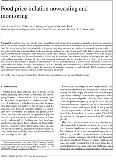Resources

Food price inflation nowcasting and monitoring
08/05/2024
To capture soaring food prices and help in designing mitigating measures, we developed two complementary products: a nowcasting model that estimates official food consumer price inflation up to the current month and a daily food price monitor that checks whether the growth rate of a few basic food commodities exceeds a statistical threshold.
.tmb-th600x450.png?Culture=en&sfvrsn=8b9e1330_1)
Bridging Agricultural Data Gaps: Innovations in Geospatial and Non- Conventional Data Sources
04/12/2023
Official statistics play a crucial role in decision-making processes. However, this process can be significantly hindered by data gaps. Addressing these data gaps is essential to ensure that the statistics we rely on for understanding various aspects of society are as robust, representative, and useful as possible. This endeavor not only enhances the quality of the data but also bolsters the integrity and efficacy of the decisions based on them.

The State of Food Security and Nutrition in the World 2023
01/07/2023
This report provides an update on global progress towards the targets of ending hunger (SDG Target 2.1) and all forms of malnutrition (SDG Target 2.2) and estimates on the number of people who are unable to afford a healthy diet.

Unsupervised Pretrain, Supervised Fine-Tune and Knowledge Distillation in the domain of Artificial Intelligence for Earth Observation applied to Developing Countries
16/05/2023
The use of Deep Neural Networks to extract patterns and features from Satellite acquisitions is nowadays widely used. Neural Networks exploit their multitude of parameters and ground truth to classify images with one or more labels or to segment objects within the image itself. This paper presents a state-of-the-art approach able to dribble the scarcity of in-situ data in difficult areas, such as Yemen, Syria, and Lesotho to eventually compute the land cover map at any administrative level.

Synthesizing Food System Summit National Pathways - A methodological approach
16/05/2023
The Food System Summit was launched in September 2021 as part of the Decade of Action to achieve the Sustainable Development Goals resulting in 117 National Pathways that aim to define the agri-food system transformation needed at the country level. This paper presents the methodology devised and implemented by the FAO Data Lab, which uses text-mining tools and manual evaluations to draw insights into the National Pathways.

United Nations Activities on Artificial Intelligence (AI) 2022
01/01/2023
2022 Edition - Urgent action is needed to achieve the Sustainable Development Goals (SDGs) by 2030. With the potential to drive progress across all 17 SDGs, the use of Artificial Intelligence (AI) can help speed and scale interventions for this purpose. Recognizing this, the different bodies, agencies, offices and departments of the UN system have been exploring ways to leverage the potential of AI to drive change and impact across their issue areas.

Assessing the impacts of the COVID-19 pandemic on the livelihoods of rural people
01/11/2022
In this paper we focus specifically on differences in the welfare impacts of COVID-19 on rural livelihoods between countries using nationally representative data that we disaggregate by food system typology. This typology captures key structural differences in the organization of rural economies and the vulnerabilities to rural livelihoods due to the COVID-19 pandemic and associated lockdown measures.

The FAO Data Lab on statistical innovation and the use of big data for the production of international statistics
13/09/2022
Data is an extremely important intangible good, but official data is not always available. It may be scarce for many reasons, among which: low statistical capacities, poor funding for data and statistics, weak data dissemination and use culture. A solution to fill data gaps needs to consider that there is data made available on the web, usually coming in an unstructured way, that can be combined with innovative methods to generate relevant information.
5129cd9f-5086-43c1-8af0-96e81219748d.tmb-th600x450.png?Culture=en&sfvrsn=df03a01e_1)
Food Systems Summit Country Transformation Pathways - What we learned and what is next?
02/08/2022
The Food Systems Summit resulted in 116 National Pathways, which aimed to define the agri-food system transformations needed at the country level. This paper uses text-mining tools to extract and categorize information on effective policy interventions proposed in these transformation pathways, aiming to derive the current priorities that countries have defined as the pillars of their food systems transformation.

A data-driven approach to measuring the COVID-19 impact on Economic and Social areas
01/01/2021
The United Nations and all member organizations of the Committee for the Coordination of Statistical Activities (CCSA) collect and make available a wealth of information for assessing the multifaceted impacts of the pandemic. This report updates some of the global and regional trends presented in the first and second volumes and offers a snapshot of how COVID-19 continues to affect the world today across multiple domains.

United Nations Activities on Artificial Intelligence (AI) 2021
01/01/2021
2021 Edition - Urgent action is needed to achieve the Sustainable Development Goals (SDGs) by 2030. With the potential to drive progress across all 17 SDGs, the use of Artificial Intelligence (AI) can help speed and scale interventions for this purpose. Recognizing this, the different bodies, agencies, offices and departments of the UN system have been exploring ways to leverage the potential of AI to drive change and impact across their issue areas.
